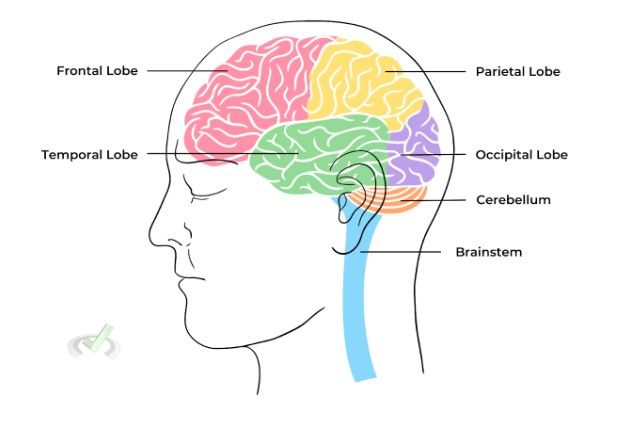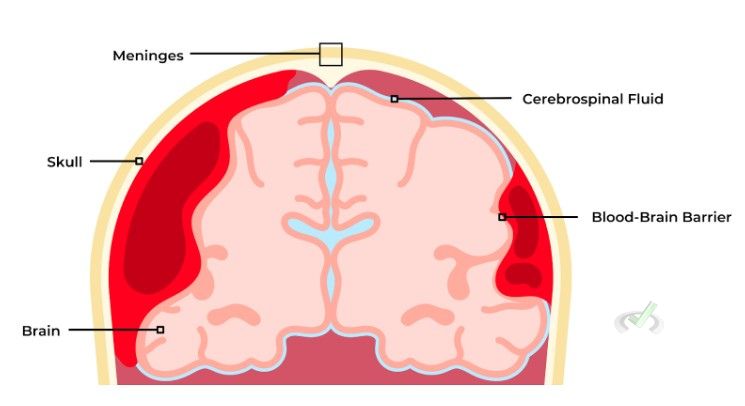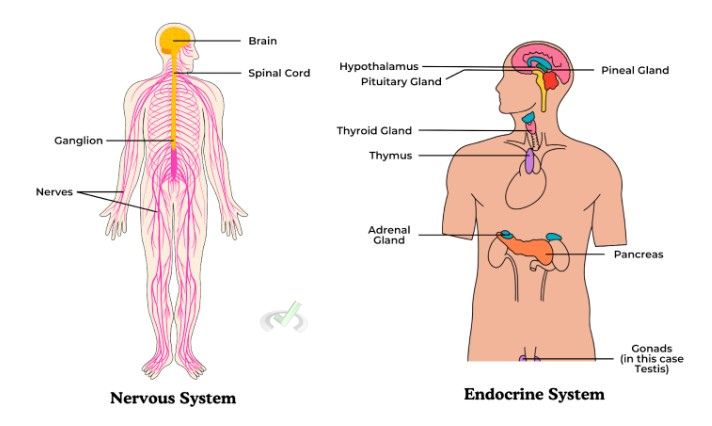Suppose you're reading a book and suddenly remember your friend's birthday. Your brain processes this information in seconds. It uses various parts to manage thoughts, memories, and emotions.
The brain is the central organ of our nervous system. It controls everything from thinking to basic survival functions. Each part of our brain plays a specific role in keeping us alive and functioning. Let's explore in detail the major structures of the brain and how they work together.

I. The Brain's Major Parts
The brain has several key parts, each with specific roles:
A. Cerebrum
The largest part of the brain is called the cerebrum. It handles voluntary activities, sensory perception, and thinking. It is divided into four lobes:
Frontal Lobe: This lobe controls thinking, planning, and voluntary movements. It acts as the brain's command center for decision-making. It helps you make choices and plans.
Parietal Lobe: This lobe processes sensory information such as touch, temperature, and pain. When you touch a hot stove, the parietal lobe helps you react.
Temporal Lobe: This lobe is involved in hearing and memory. It helps you recognize sounds, understand speech, and remember facts or experiences.
Occipital Lobe: This lobe is responsible for our vision. It processes everything you see, from colors to shapes. The occipital lobe helps you understand visual information.
B. Cerebellum
The cerebellum, located under the cerebrum, is responsible for balance and coordination. It ensures your movements are smooth and precise. For example, when you catch a ball, the cerebellum helps you coordinate your hand and eye movements.
C. Brainstem
The brainstem controls automatic functions like breathing, heart rate, and digestion. It manages basic life functions without you having to think about them. The brainstem is the structure that connects the cerebrum and cerebellum to the spinal cord.
II. Protection and Support Structures
The brain is well protected and supported by several structures:
A. Skull and Meninges
The brain is enclosed in the skull, a hard, bony structure that shields it from injury. Inside the skull are three layers of membranes.
These are called meninges that provide additional protection and support. Meninges cover the brain and spinal cord.
B. Cerebrospinal Fluid
Cerebrospinal fluid surrounds our brain and the spinal cord. It cushions the brain, helping to absorb shocks and prevent injuries. The fluid also removes the waste products from our brain.
C. Blood-Brain Barrier
The blood-brain barrier is a protective mechanism. It regulates what substances can enter the brain from the bloodstream. Also, it helps keep harmful substances out while allowing nutrients to pass through.

III. Communication Within the Brain
The brain communicates through a network of neurons. Neurons are specialized cells that send and receive signals.
A. Neurons
Each neuron has three main parts:
- Cell Body: Contains the nucleus and processes information.
- Dendrites: Branch-like structures that receive signals from other neurons.
- Axon: A long fiber that sends signals to other neurons, muscles, or glands.

B. Synapses and Neurotransmitters
Neurons communicate at junctions called synapses. When a signal reaches the end of an axon, it releases chemicals called neurotransmitters.
These neurotransmitters cross the synapse. Then, they attach to receptors on the next neuron, continuing the signal.
Examples of Neurotransmitters
- Dopamine: Involved in movement, emotion, and the reward system.
- Serotonin: Affects mood, appetite, and sleep.
- Acetylcholine: Responsible for muscle action and memory.
C. Glial Cells
Glial cells support and protect neurons. They provide nutrients, maintain the environment around neurons, and help repair damage. Types of glial cells include the astrocytes, oligodendrocytes, and microglia.
IV. Major Brain Functions
The brain performs several critical functions:
A. Sensory Processing
The brain receives and processes information from the senses. It helps you see, hear, smell, taste, and touch.
Each sensory input is processed in specific areas of the brain. This helps you understand your surroundings.
B. Motor Control
The brain sends signals to muscles, directing movements. It controls everything from walking to picking up objects. Different parts of the brain plan and execute these movements.
C. Cognitive Functions
These include thinking, memory, decision-making, and problem-solving. The brain helps you learn, remember, and plan. Cognitive functions involve interactions between different brain regions.
D. Emotional Regulation
The brain manages emotions, helping you respond to different situations. The limbic system includes structures like the amygdala and hippocampus. It is important in processing emotions and forming memories.
V. Disorders of the Brain
Understanding the brain's structure and function helps identify and treat disorders. Common brain disorders include:
- Alzheimer's Disease: A condition that impairs memory and cognitive function. It involves the degeneration of neurons. It is associated with plaques and tangles in the brain.
- Parkinson's Disease: A disorder affecting movement and coordination. Usually caused by the loss of dopamine-producing neurons in the brain.
- Stroke: This condition occurs whenever blood flow to a part of the brain is interrupted, damaging brain tissue. It can result from a blocked artery or a burst blood vessel.
Early diagnosis and treatment are crucial. These facilitates the management of these conditions and improve the quality of life.
VI. Brain and Other Body Systems
The brain interacts closely with other body systems:
A. Nervous and Endocrine Systems

The brain works with the endocrine system to maintain body balance. The hypothalamus, located in the brain, controls the pituitary gland.
The pituitary gland regulates various hormones in the body. For example, it controls growth hormone, thyroid hormone, and cortisol levels.
B. Nervous System and Mental Health
Neurotransmitter imbalances are often linked to psychological disorders. For instance, when serotonin is low, it can cause depression.
Dopamine imbalances are linked to schizophrenia and Parkinson's disease. Understanding these connections helps in the development of medications to treat these disorders.
C. Nervous and Cardiovascular Systems
The autonomic nervous system, a part of the brain, regulates the cardiovascular system. The sympathetic nervous system increases blood pressure and heart rate when stressed.
The parasympathetic nervous system helps to lower them during relaxation. This interaction is vital for maintaining cardiovascular health.
VII. Bridge: Extending Beyond the Brain
A. Neuroplasticity
Neuroplasticity is the ability of our brain to reorganize itself by forming new neural connections. This ability is important for learning, memory, and recovery from brain injuries.
Engaging in new activities can enhance neuroplasticity. Understanding this can help in developing therapies for conditions like stroke and brain injuries.
B. Neurotransmitters and Drug Action
Drugs can affect neurotransmitter levels and activity. For instance, antidepressants like SSRIs (selective serotonin reuptake inhibitors) increase serotonin levels in the brain.
Thus, it helps improve mood and reduce symptoms of depression. Understanding how drugs interact with neurotransmitters is important for treating mental health disorders.
C. Brain Imaging Techniques
Modern techniques like MRI (Magnetic Resonance Imaging) and PET (Positron Emission Tomography) scans allow us to see the brain's structure and function in detail. These tools help diagnose brain disorders and understand brain activity.
MRI uses magnetic fields in order to create detailed images of the brain. PET scans use a radioactive substance to show how the brain is working.
D. Brain-Computer Interfaces (BCIs)
BCIs are devices that facilitate direct communication between the brain and external devices. This technology can help people with disabilities control prosthetic limbs or communicate through thought alone. BCIs can detect brain signals and translate them into commands for a computer or device.
VIII. Wrap-Up and Key Terms
Let's summarize what we covered in this article!
- Cerebrum: The largest part of the brain. It is responsible for voluntary activities, sensory perception, and thinking. Divided into four lobes, namely frontal, parietal, temporal, and occipital.
- Cerebellum: Located under the cerebrum, responsible for balance and coordination.
- Brainstem: Controls automatic functions like breathing and heart rate.
- Neurons: Specialized cells that send and receive signals in the brain.
- Neurotransmitters: Chemicals that transmit signals between neurons.
- Glial Cells: Support and protect neurons.
- Common Brain Disorders: Alzheimer's disease, Parkinson's disease, and stroke.
- Brain Interactions: Works with the endocrine system for hormonal regulation. Also interacts with the cardiovascular system for regulating heart rate and blood pressure.
- Neuroplasticity: The brain's ability to reorganize itself through forming new neural connections.
- Neurotransmitters and Drug Action: Understanding how drugs interact with neurotransmitters to treat disorders.
- Brain Imaging Techniques: Tools like MRI and PET scans that help diagnose and understand brain activity.
- Brain-Computer Interfaces: Technology enabling communication between the brain and external devices.
IX. Practice Questions
Sample Practice Question 1
Which lobe of the brain is responsible for processing sensory information like touch and temperature?
A. Frontal Lobe
B. Parietal Lobe
C. Temporal Lobe
D. Occipital Lobe
Ans. B
The parietal lobe processes sensory information such as touch, temperature, and pain.
Sample Practice Question 2
What part of the human brain controls automatic functions like breathing and heart rate?
A. Cerebrum
B. Cerebellum
C. Brainstem
D. Spinal Cord
Ans. C
The brainstem controls automatic functions like breathing, heart rate, and digestion.







 To help you achieve your goal MCAT score, we take turns hosting these
To help you achieve your goal MCAT score, we take turns hosting these 





















 reviews on TrustPilot
reviews on TrustPilot